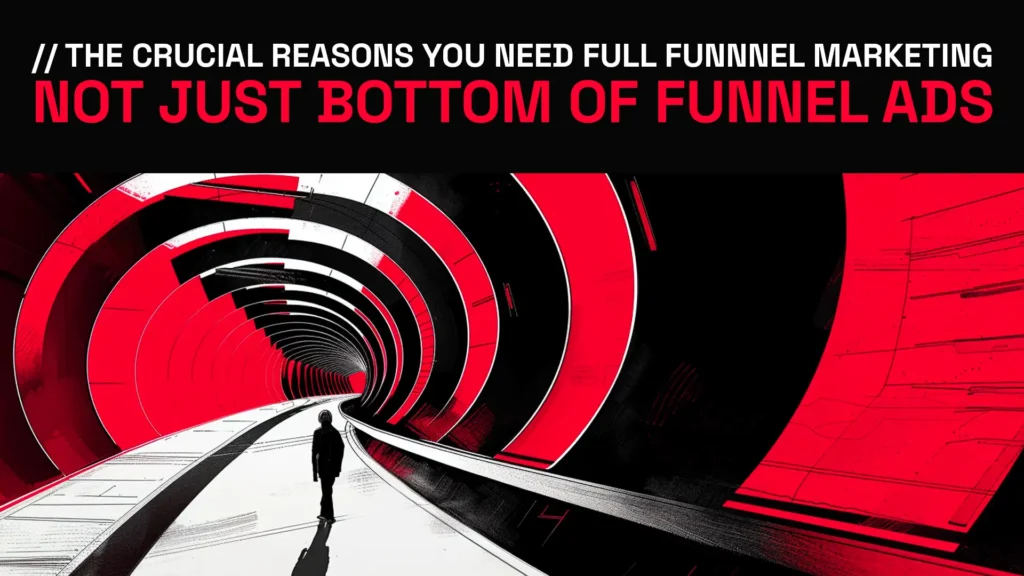
THE CRUCIAL REASONS YOU NEED FULL FUNNEL MARKETING, NOT JUST BOTTOM OF FUNNEL ADS
As a small business owner, you know every dollar counts when it comes to your marketing budget. It’s tempting to focus all your efforts on bottom-of-funnel ads that drive immediate sales. After all, what’s the point of advertising to people who aren’t ready to buy right now?
But here’s the thing: only running bottom-funnel ads is like trying to build a house without laying a foundation. You might get some quick results, but without the groundwork of brand awareness and customer nurturing, those results won’t be sustainable. In this article, we’ll dive into why a full-funnel marketing approach is crucial for small business success, and how you can make it work on a budget. Get ready to rethink your marketing strategy and set your business up for long-term growth.
YOU’RE MISSING OUT ON BUILDING BRAND AWARENESS:
Picture a local HVAC contractor that only advertises to people searching for “AC repair near me” or “furnace replacement” at that very moment. While they may get some jobs from those homeowners with an immediate need, they’re missing out on the opportunity to build brand awareness with a much wider audience of potential future customers.
Imagine if instead, that HVAC company also ran informative blog posts and engaging social media content educating homeowners on the importance of regular HVAC maintenance, energy-saving tips, and signs it’s time for an upgrade. They’d start building trust, credibility, and top-of-mind awareness – so when those homeowners do need HVAC services, whether now or months down the line, that company is the first one they think of.
As Seth Godin puts it, “Marketing is no longer about the stuff that you make, but about the stories you tell.” Top of funnel brand-building allows you to start telling your story.
THE IMPORTANCE OF GUIDING CUSTOMERS THROUGH THEIR JOURNEY:
The customer journey is often compared to a funnel, starting wide at the top with many potential customers who first discover your brand, then narrowing down to the few who ultimately make a purchase. Effective marketing meets the customer at each stage of this journey.
By only focusing on the bottom, you’re assuming customers will find their own way through the rest of the funnel. But in reality, customers need to be nurtured and guided, with touchpoints that build trust, educate them on your offering, and keep you top of mind during their decision-making process. As the old marketing adage goes, customers need to hear your message AT LEAST 7 times (This number has gone up considerably over time) before they’ll consider purchasing. Relying solely on bottom-funnel tactics cuts out the essential first several touches.
EXPANDING YOUR AUDIENCE FOR LONG-TERM GROWTH:
Exclusively running bottom-funnel ads is like fishing in a small pond, ignoring the vast ocean right next door. You’re limiting yourself to a tiny audience of people with high purchase intent at that moment. While hyper-targeting can sometimes work in the short-term, it’s the broader brand-building that fuels long-term growth.
Think of brands like Coca-Cola or Nike – they’ve achieved such immense success not by only targeting ready-to-purchase customers, but by building strong brand awareness, associations, and loyalty among a wide audience over time. As a small business, you can apply this same principle on a local level. Expanding your audience with top-of-funnel campaigns plants seeds that can blossom into a larger, more resilient customer base down the line.


BALANCING SHORT-TERM RESULTS WITH LONG-TERM STRATEGY:
Of course, none of this is to say bottom-funnel ads don’t have an important place – when done right, they’re key for driving short-term sales. The mistake is only doing bottom-funnel advertising. The most effective marketing strategies find a balance, using bottom-funnel alongside top and mid-funnel tactics for a healthy mix of short-term results and long-term growth.
As marketing thought leader Les Binet puts it, “The key to effective marketing is to find the right balance between brand building and sales activation.” For small businesses on a budget, that might mean dedicating 60% of spend to performance-focused lower-funnel ads and 40% to upper-funnel brand-building, then adjusting that ratio based on results over time.
The bottom line? Build a full-funnel marketing strategy that expands your audience, nurtures customer relationships, and drives both short and long-term growth. Your future self – and future customers – will thank you.
CONCLUSION:
In today’s competitive landscape, small businesses can’t afford to ignore the power of full-funnel marketing. By expanding your efforts beyond just bottom-funnel ads, you open up a world of opportunity to build brand awareness, nurture customer relationships, and drive sustainable growth.
Like a skilled gardener tending to plants at every stage of growth, a savvy marketer knows that each stage of the funnel plays a vital role in the customer journey. So tend to your entire marketing funnel – from the seeds of awareness to the fruits of conversion – and watch your business bloom. As management expert Peter Drucker wisely said, “The aim of marketing is to know and understand the customer so well the product or service fits him and sells itself.” With a full-funnel approach, you’ll be well on your way to achieving just that.


